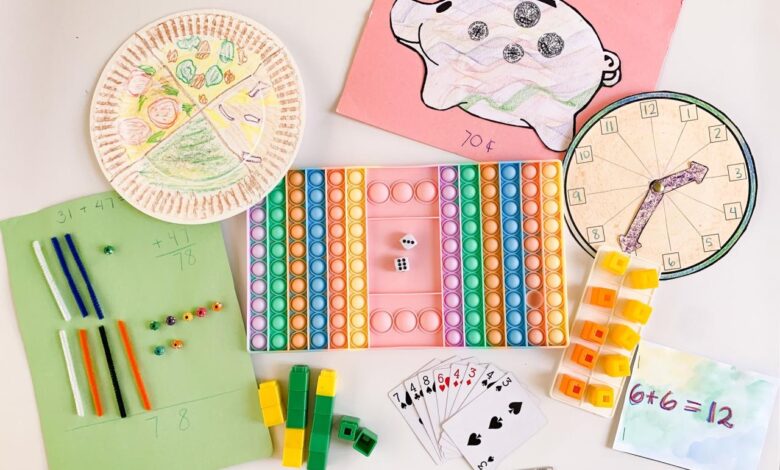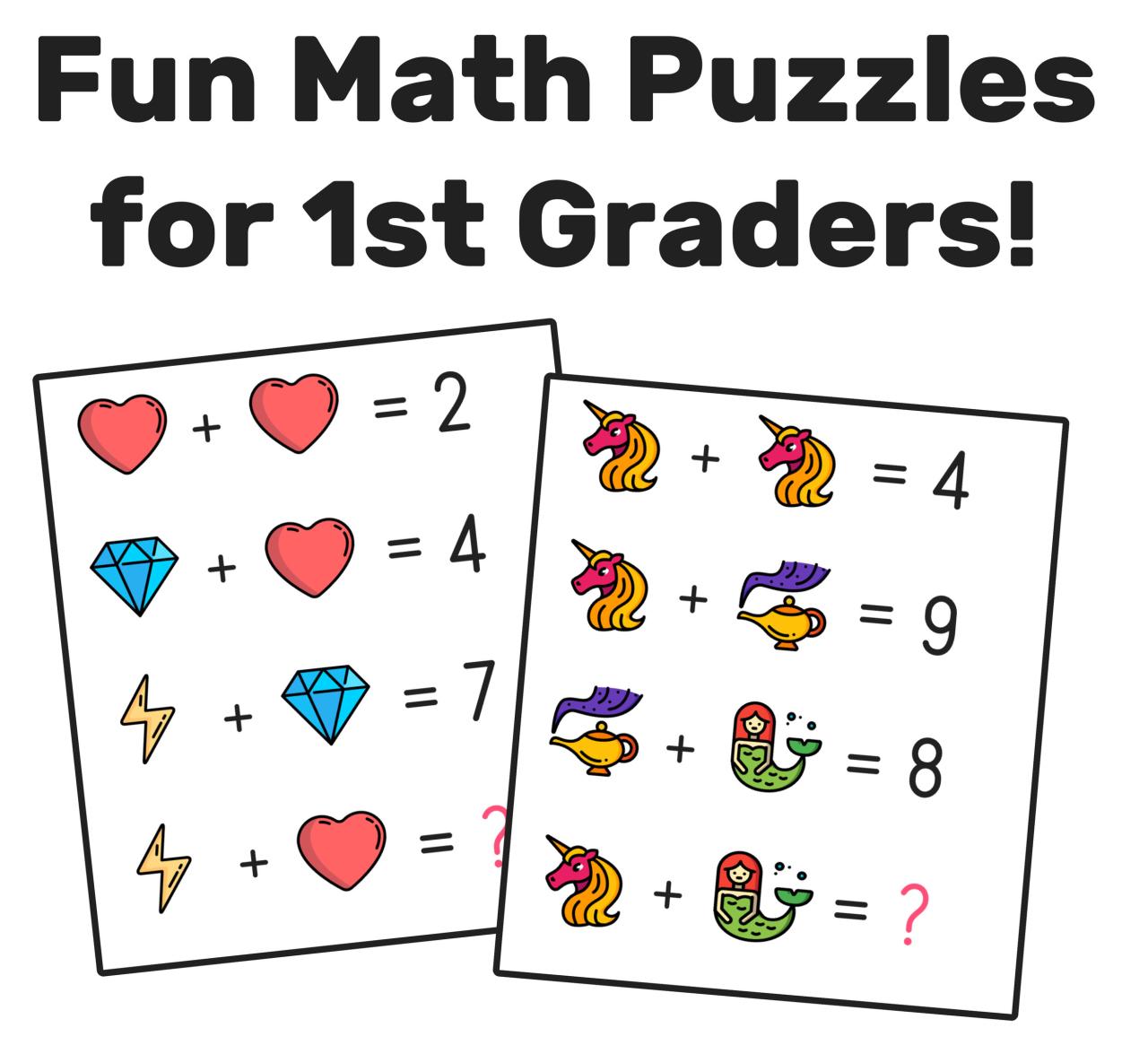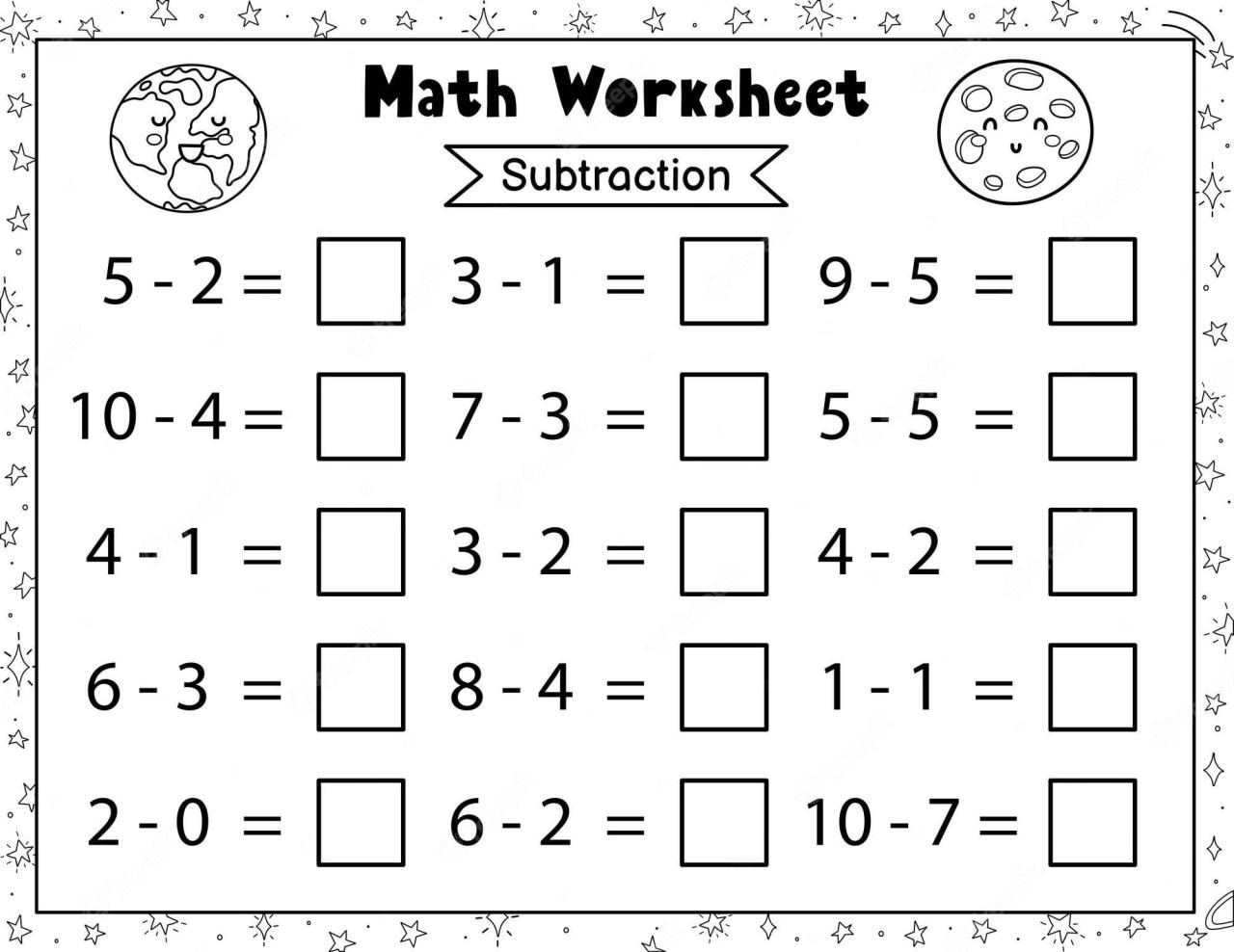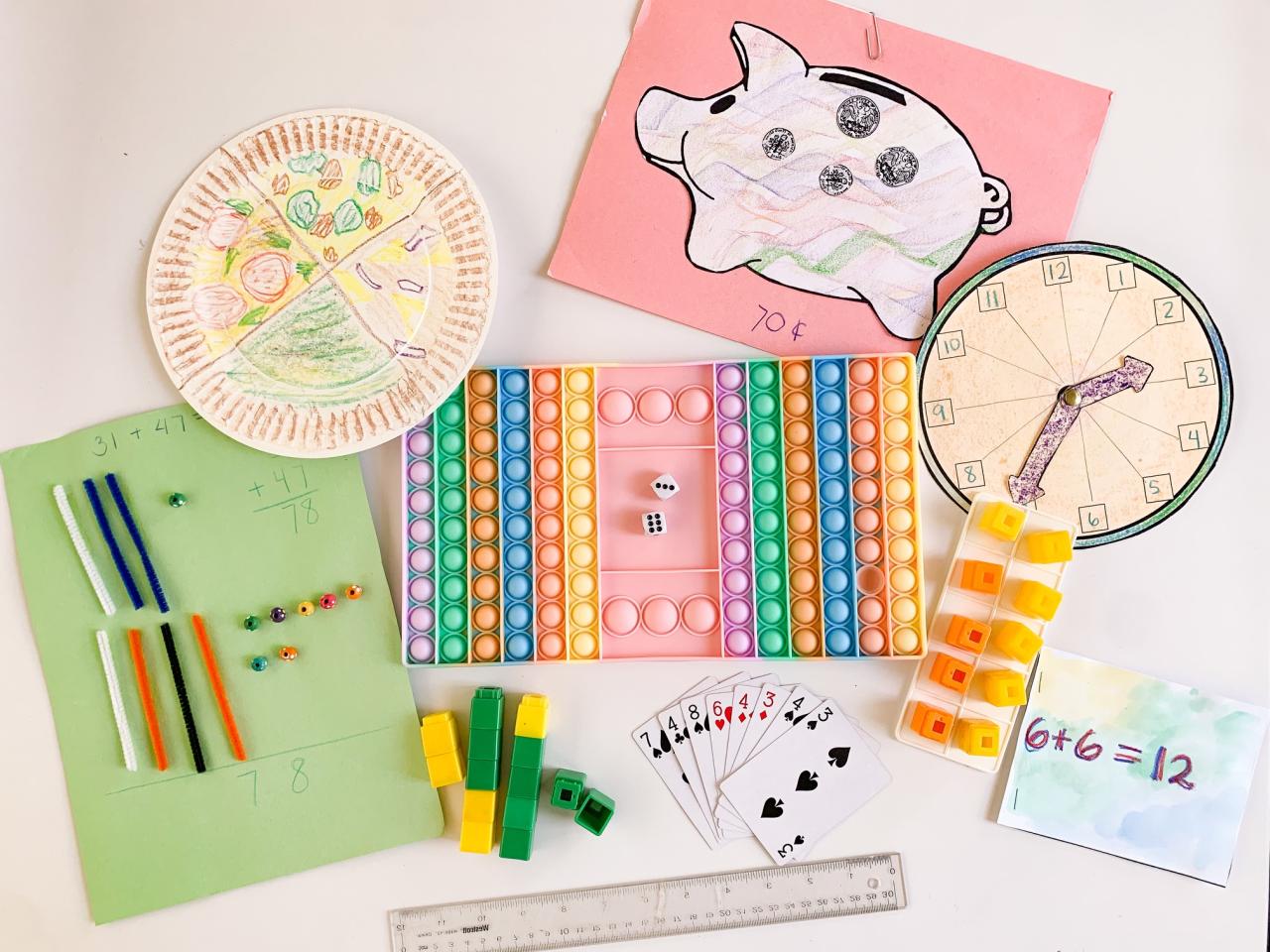
25 Fun and Free First Grade Math Games and Activities
25 Fun and Free First Grade Math Games and Activities: Imagine a classroom buzzing with excitement as kids learn math through games! This is the magic we’re about to unlock. Forget boring worksheets and textbooks – we’re diving into a world of hands-on activities, playful challenges, and engaging learning experiences that make math fun and accessible for first graders.
Get ready to transform your classroom into a vibrant playground of mathematical exploration!
This blog post will guide you through a treasure trove of fun and free math games and activities perfect for first graders. We’ll cover everything from number recognition and counting to addition, subtraction, geometry, measurement, and problem-solving. We’ll also explore ways to make learning interactive and engaging, incorporating music, movement, and even art into math activities.
So, whether you’re a teacher looking for fresh ideas or a parent wanting to help your child learn, get ready to discover a world of exciting math adventures!
Number Recognition and Counting
Number recognition and counting are foundational skills in mathematics, essential for understanding quantity and developing a strong mathematical foundation. First-graders are typically learning to recognize numbers from 1 to 100 and count objects within that range. This section will explore engaging games and activities to help students develop these skills.
Number Recognition Games
Number recognition games provide opportunities for students to practice identifying numbers and associating them with their corresponding quantities. These games can be adapted to different learning styles and skill levels.
- Number Bingo:This classic game involves calling out numbers and having students mark them on their bingo cards. Students need to recognize the numbers and match them to their corresponding squares on the card.
- Number Match:Prepare sets of cards with numbers and matching sets of cards with pictures representing those numbers. Students can match the number cards to the corresponding picture cards. This helps them connect the abstract symbol with its concrete representation.
- Number Hunt:Hide number cards or objects around the classroom. Students can then search for the hidden items and identify the numbers. This activity encourages movement and active learning.
Using Manipulatives for Counting
Manipulatives, such as blocks, counters, or other tangible objects, can be invaluable tools for teaching counting. They provide a concrete representation of numbers, allowing students to visualize and manipulate quantities.
- Counting with Blocks:Students can use blocks to build towers or other structures while counting the number of blocks used. This provides a hands-on experience that reinforces the concept of one-to-one correspondence.
- Counter Activities:Counters can be used for a variety of counting activities, such as sorting by color, creating patterns, or counting objects in a specific set. This helps students develop counting skills and explore different mathematical concepts.
- Number Line with Counters:Create a number line using a long strip of paper or tape. Students can then use counters to represent numbers on the number line. This activity helps them visualize the order of numbers and understand the concept of a number line.
Number-Quantity Matching Game
This game helps students match numbers to their corresponding quantities.
Materials:
- Index cards
- Markers
- Small objects (counters, buttons, etc.)
Instructions:
- On each index card, write a number from 1 to 10.
- On a separate set of index cards, draw a corresponding number of objects.
- Spread out the number cards face up on a table or the floor.
- Students take turns picking a number card and matching it to the corresponding quantity card.
- Continue playing until all cards have been matched.
Addition and Subtraction: 25 Fun And Free First Grade Math Games And Activities
First graders are just beginning to grasp the concepts of addition and subtraction. Hands-on activities and visual aids are essential to help them understand these foundational math concepts.
Hands-on Activities for Addition and Subtraction
Hands-on activities make learning fun and engaging for young learners. Here are some examples:
- Counting Objects:Use everyday objects like blocks, toys, or buttons to demonstrate addition and subtraction. For example, start with 3 blocks, add 2 more, and count the total number of blocks (5). To demonstrate subtraction, remove 1 block and count the remaining blocks (4).
- Number Puzzles:Use puzzle pieces with numbers on them. Students can create addition or subtraction equations by matching the pieces. For example, they can combine a piece with the number 2 and a piece with the number 3 to create the equation 2 + 3 = 5.
- Beanbag Toss:Create a game board with numbered squares. Students toss beanbags onto the board and add up the numbers on the squares where the beanbags land. To make it more challenging, have students subtract the numbers on the squares.
Using Number Lines to Solve Addition and Subtraction Problems
Number lines are visual tools that help students understand the relationship between numbers and the concept of adding and subtracting.
- Addition:To add 2 + 3, start at the number 2 on the number line and move 3 spaces to the right. The final position on the number line represents the sum (5).
- Subtraction:To subtract 5 – 2, start at the number 5 on the number line and move 2 spaces to the left. The final position on the number line represents the difference (3).
Addition and Subtraction Game
This game helps students practice solving simple addition and subtraction equations while moving along a game board.
- Materials:A game board with numbered squares, dice, game pieces for each player, and index cards with addition and subtraction equations.
- Instructions:
- Players take turns rolling the dice and moving their game piece the corresponding number of spaces on the game board.
- When a player lands on a square, they draw an index card with an addition or subtraction equation.
- If the player solves the equation correctly, they can continue playing. If they get the answer wrong, they stay on the same square.
- The first player to reach the end of the game board wins.
Geometry and Shapes
Introducing geometric shapes to first graders can be a fun and engaging experience. By using hands-on activities and real-world examples, students can learn to identify, classify, and understand the properties of basic shapes like squares, circles, and triangles.
Introducing Basic Shapes
Introducing basic geometric shapes to first graders can be a fun and engaging experience. By using hands-on activities and real-world examples, students can learn to identify, classify, and understand the properties of basic shapes like squares, circles, and triangles.
Teaching first grade math can be a blast, and it doesn’t have to break the bank! With a little creativity, you can easily come up with 25 fun and free games and activities to engage your little learners. It’s amazing how quickly they pick up new concepts when they’re having fun, like playing with blocks or sorting objects.
It’s a stark contrast to the news we’ve been seeing lately, where texas gun laws allow 18 year olds to buy ar 15s the weapons used in uvalde shooting. It makes you want to focus even harder on building positive experiences for kids, and math is a great place to start.
So, get those counting bears and dice ready – let’s make learning fun!
- Use real-world objects:Start by showing students familiar objects that represent different shapes, such as a round pizza for a circle, a square book, or a triangular slice of cake. This helps them connect abstract shapes to concrete examples.
- Hands-on activities:Engage students with activities like building shapes using blocks, drawing shapes on a whiteboard, or cutting out shapes from paper. This allows them to manipulate and explore shapes in a tactile way.
- Shape puzzles:Use shape puzzles where students need to fit different shapes together to create a picture. This helps them understand the relationship between different shapes and how they can be combined.
- Shape songs and rhymes:Sing shape-themed songs or recite rhymes that introduce different shapes and their names. This helps make learning fun and memorable.
Identifying and Classifying Shapes
Once students have been introduced to basic shapes, they can start identifying and classifying them based on their attributes. This helps them develop critical thinking skills and spatial reasoning.
- Sorting activities:Provide students with a variety of shapes and ask them to sort them by their attributes, such as color, size, or number of sides. This helps them practice identifying and comparing shapes.
- Shape scavenger hunt:Have students go on a scavenger hunt around the classroom or playground to find objects that match specific shapes. This makes learning interactive and engaging.
- Shape books:Read books that focus on shapes, such as “The Very Hungry Caterpillar” by Eric Carle or “Shapes, Shapes, Shapes” by Tana Hoban. This introduces shapes in a story context.
- Shape bingo:Create a shape bingo game where students need to match shapes on their bingo cards to those called out by the teacher. This is a fun way to practice shape recognition.
Shape Sorting Game, 25 fun and free first grade math games and activities
Here’s a fun game that helps students sort shapes based on their attributes: Materials:* A set of colorful construction paper cut into different shapes (squares, circles, triangles, rectangles)
Keeping first graders engaged in math can be a challenge, but with 25 fun and free activities, learning can be a blast! From counting games to measurement activities, there’s something for every learning style. Speaking of learning, I just read that a House panel is holding a public hearing on unexplained aerial sightings house panel to hold public hearing on unexplained aerial sightings – that’s certainly a different kind of learning experience! But back to our first graders, these activities are sure to make math fun and memorable for them.
Three containers labeled “Squares,” “Circles,” and “Triangles”
Instructions:
Finding engaging ways to teach first graders math can be a challenge, but it doesn’t have to be a chore! There are tons of fun and free activities that can make learning math exciting, like building towers with blocks to practice counting and measurement.
Speaking of exciting, it’s been interesting to see the political landscape shift, with Bernie Sanders not ruling out another presidential run. It’s all about finding what sparks interest and making learning a positive experience, just like those fun and free math games and activities!
- Scatter the shapes on the floor or table.
- Have students take turns picking up a shape and identifying its name.
- Ask students to sort the shapes into the correct container based on their attributes (e.g., a square goes in the “Squares” container).
- Continue playing until all shapes are sorted.
Variations:* You can add more containers for other shapes like rectangles or ovals.
You can also introduce other attributes for sorting, such as color or size.
This game encourages students to identify shapes, practice their sorting skills, and learn about the attributes of different shapes.
Measurement and Time

First graders are beginning to grasp the world around them, and measurement and time are essential concepts for them to understand. Through engaging activities, we can help them develop a strong foundation in these areas.
Introducing Length, Weight, and Capacity
It’s important to introduce these concepts through hands-on activities. This allows students to directly experience and compare different measurements.
- Length:Use objects like string, blocks, or paperclips to measure the length of various items in the classroom. Have students compare the lengths of different objects, such as a pencil and a book. This helps them understand the concept of longer and shorter.
- Weight:Use a balance scale to compare the weights of different objects. Have students place objects on each side of the scale and observe which side goes down. This helps them understand the concepts of heavier and lighter.
- Capacity:Use different containers, such as cups, bowls, and pitchers, to compare the capacities of different objects. Have students fill containers with water or sand and compare how much each container holds. This helps them understand the concepts of more and less.
Telling Time with Analog and Digital Clocks
Teaching students how to tell time using both analog and digital clocks is crucial for their understanding of time.
- Analog Clocks:Start by introducing the hour hand and minute hand, explaining their roles in telling time. Use a large clock and have students move the hands to different positions to represent different times. Play games like “Guess the Time” where students guess the time based on the position of the hands.
- Digital Clocks:Once students understand analog clocks, introduce them to digital clocks. Show them how the numbers on the digital clock correspond to the position of the hands on the analog clock. Use a digital clock and have students practice reading the time.
Measuring with Non-Standard Units
This game allows students to practice measuring objects using non-standard units, like paperclips or blocks.
Game: “Measure It Up”
- Materials:Paperclips, blocks, objects of various lengths (e.g., pencils, crayons, books).
- Instructions:Divide the students into small groups. Have each group choose an object to measure. Provide each group with a specific non-standard unit (e.g., paperclips, blocks).
- Procedure:Students measure the object using their chosen unit and record their findings. They can then compare their measurements with other groups to see if they got similar results.
Problem-Solving and Critical Thinking
First graders are beginning to develop their problem-solving and critical thinking skills. By incorporating these skills into math activities, you can help them build a strong foundation for future learning.Encouraging first graders to think critically and solve simple word problems involves creating a fun and engaging learning environment.
Problem-Solving Strategies
It’s important to teach first graders different problem-solving strategies. Here are some examples:
- Read the problem carefully: Encourage students to read the problem slowly and identify the key information. This involves understanding what the problem is asking and what information is needed to solve it.
- Draw a picture: Visualizing the problem can help students understand the situation better. Encourage them to draw a picture or diagram to represent the problem. This visual representation can help them identify the relationships between the different parts of the problem and make it easier to solve.
- Use manipulatives: Using hands-on materials like blocks, counters, or number lines can help students visualize the problem and manipulate the objects to find the solution. This can be especially helpful for students who are still developing their understanding of abstract concepts.
- Act it out: Acting out the problem can be a fun and engaging way for students to understand the situation. Encourage them to use their bodies and movements to represent the different parts of the problem.
- Write an equation: Once students have a good understanding of the problem, they can write an equation to represent it. This can help them identify the operation they need to use to solve the problem.
Games for Problem-Solving
There are many games that can help first graders develop their problem-solving skills. Here are a few examples:
- Logic Puzzles: Logic puzzles require students to use their reasoning skills to solve problems. These puzzles often involve matching shapes, colors, or patterns to solve a riddle.
- Board Games: Board games can be a great way for students to practice their problem-solving skills. Games like Candy Land or Chutes and Ladders involve moving pieces around a board based on the roll of a die. Students must learn to make decisions based on the numbers they roll and their position on the board.
- Card Games: Card games like Go Fish or War can help students develop their problem-solving skills by requiring them to make decisions based on the cards they have. These games also involve counting and comparing numbers.
Challenge Game
Here’s an example of a game that can be used to help first graders develop their problem-solving skills: The Treasure Hunt
- Materials: You will need a map, some small prizes, and a few clues that require students to solve math problems to find the treasure.
- Set Up: Hide the treasure in a secret location and create a map with clues that lead to the treasure. Each clue should require students to solve a math problem.
- How to Play: Students work in teams to follow the map and solve the math problems to find the treasure.
- Example Clues:
- Start at the door with the red handle. Take 3 steps forward and then 2 steps to the right. How many steps did you take in total? (5 steps)
- Find the book with 4 pictures on the cover. How many more pictures would you need to have 7 pictures on the cover? (3 pictures)
- Count the number of windows in the classroom. Subtract 2 from that number. Go to the window that corresponds to that number. (The answer will tell them which window to go to)
Fun and Engaging Activities

Making math fun and engaging for first graders is essential for their learning and development. By incorporating games, activities, and real-life applications, you can create a positive and stimulating environment where they can explore mathematical concepts in a hands-on and interactive way.
Incorporating Music, Movement, and Art
Music, movement, and art can enhance the learning experience and make math more enjoyable for first graders. Here are some ways to incorporate these elements:
- Musical Counting:Play counting songs and have children clap, stomp, or jump along to the rhythm. You can also use musical instruments like tambourines or shakers to represent different numbers.
- Movement Activities:Incorporate movement into math activities, such as having children skip, hop, or jump to represent different numbers or shapes.
- Art and Math:Create geometric shapes using building blocks, playdough, or art supplies. Have children draw pictures that represent different mathematical concepts, such as patterns or measurement.
Combining Math with Other Subjects
Integrating math with other subjects like science, social studies, or art can create a more holistic and engaging learning experience. Here are some examples:
- Science and Math:Conduct experiments that involve measuring, counting, or graphing data. For example, children can measure the growth of plants over time or track the number of times a ball bounces.
- Social Studies and Math:Use maps to explore distances, create timelines, or analyze population data. Children can also learn about different cultures through math activities like comparing currency or understanding different units of measurement.
- Art and Math:Create geometric patterns using different art supplies. Children can also use math to create symmetrical designs or explore the concept of perspective in drawing.
Indoor and Outdoor Games
Indoor and outdoor games provide a fun and engaging way for first graders to practice math skills. Here are some examples:
- Indoor Games:
- Number Bingo:Call out numbers and have children mark them on their bingo cards. The first person to get a bingo wins!
- Shape Matching:Create a set of cards with different shapes. Have children match the shapes on the cards or create patterns with them.
- Math Dice:Roll two dice and add the numbers together. The player with the highest sum wins.
- Outdoor Games:
- Hopscotch:Use chalk to draw a hopscotch board and have children hop on the numbered squares.
- Number Hunt:Hide number cards around the playground and have children find them. They can then add, subtract, or compare the numbers they find.
- Measurement Games:Have children measure the length of different objects using rulers or measuring tapes.
Designing a Math Game
To design a game that combines math skills with other subjects, consider the following steps:
- Choose a Theme:Select a theme that aligns with a specific subject, such as science, social studies, or art. For example, you could create a game about animals, historical events, or famous artists.
- Determine the Math Skills:Identify the math skills you want to reinforce, such as addition, subtraction, counting, or measurement.
- Develop the Game Mechanics:Create a set of rules and instructions that guide the gameplay. The game should be engaging and challenging, but also appropriate for first graders.
- Create Game Materials:Prepare the necessary materials, such as cards, dice, or game boards. You can also use objects related to the theme of the game.
- Test and Refine:Play the game with a group of children and gather feedback. Make any necessary adjustments to the rules or materials to improve the gameplay.
Resources for Teachers
Finding quality resources for first-grade math can be a rewarding experience, enriching your teaching and providing engaging learning experiences for your students. The availability of numerous online platforms, educational books, and other materials makes it easier than ever to find the perfect resources to supplement your curriculum.
Websites Offering Free Math Games
These websites provide a wide range of free math games and activities for first graders, categorized by skill level.
| Website | Skill Level | Description |
|---|---|---|
| SplashLearn | Number Recognition, Counting, Addition, Subtraction, Geometry, Measurement, Time, Problem-Solving | Offers a comprehensive collection of interactive math games, covering various first-grade math skills. |
| Khan Academy | Number Recognition, Counting, Addition, Subtraction | Provides a structured learning platform with video lessons, practice exercises, and interactive games, focusing on foundational math concepts. |
| FunBrain | Number Recognition, Counting, Addition, Subtraction, Geometry | Offers a variety of engaging games that make learning math enjoyable, covering essential first-grade skills. |
| ABCya | Number Recognition, Counting, Addition, Subtraction, Geometry, Measurement, Time | Provides a vast collection of educational games and activities, including a wide range of math resources for first graders. |
| Sheppard Software | Number Recognition, Counting, Addition, Subtraction, Geometry | Offers a diverse range of interactive math games and activities, covering basic math concepts for first graders. |
Closure

With these 25 fun and free first grade math games and activities, you have a powerful toolkit to ignite a love for math in your young learners. Remember, the key is to make learning enjoyable and engaging, so don’t be afraid to get creative and tailor these activities to your students’ interests.
Watch their confidence grow as they explore math concepts through play, and see their excitement blossom as they discover the magic of numbers!

